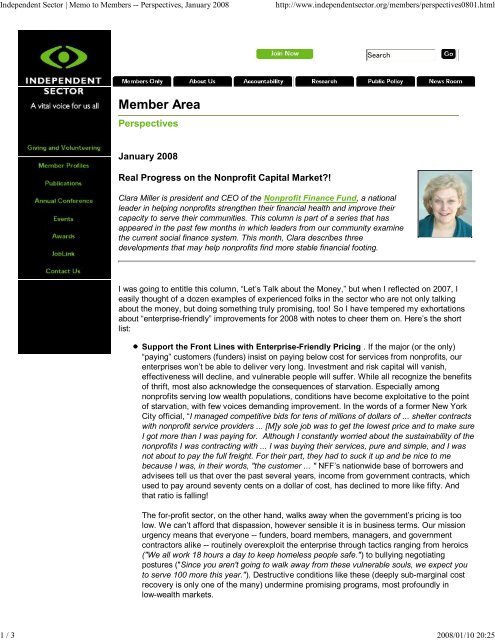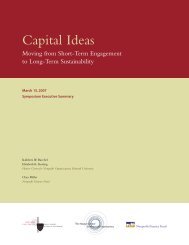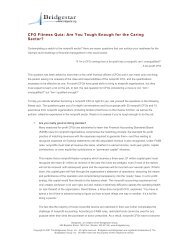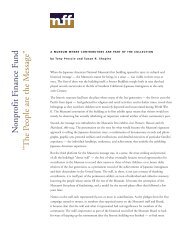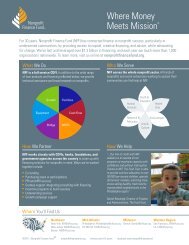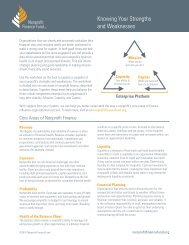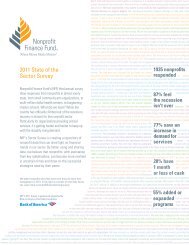Independent Sector - Memo to Members Newsletter - Nonprofit ...
Independent Sector - Memo to Members Newsletter - Nonprofit ...
Independent Sector - Memo to Members Newsletter - Nonprofit ...
You also want an ePaper? Increase the reach of your titles
YUMPU automatically turns print PDFs into web optimized ePapers that Google loves.
<strong>Independent</strong> <strong>Sec<strong>to</strong>r</strong> | <strong>Memo</strong> <strong>to</strong> <strong>Members</strong> Perspectives, January 2008<br />
http://www.independentsec<strong>to</strong>r.org/members/perspectives0801.html<br />
1 / 3 2008/01/10 20:25<br />
Search<br />
Member Area<br />
Perspectives<br />
January 2008<br />
Real Progress on the <strong>Nonprofit</strong> Capital Market?!<br />
Clara Miller is president and CEO of the <strong>Nonprofit</strong> Finance Fund, a national<br />
leader in helping nonprofits strengthen their financial health and improve their<br />
capacity <strong>to</strong> serve their communities. This column is part of a series that has<br />
appeared in the past few months in which leaders from our community examine<br />
the current social finance system. This month, Clara describes three<br />
developments that may help nonprofits find more stable financial footing.<br />
I was going <strong>to</strong> entitle this column, “Let’s Talk about the Money,” but when I reflected on 2007, I<br />
easily thought of a dozen examples of experienced folks in the sec<strong>to</strong>r who are not only talking<br />
about the money, but doing something truly promising, <strong>to</strong>o! So I have tempered my exhortations<br />
about “enterprisefriendly” improvements for 2008 with notes <strong>to</strong> cheer them on. Here’s the short<br />
list:<br />
Support the Front Lines with EnterpriseFriendly Pricing . If the major (or the only)<br />
“paying” cus<strong>to</strong>mers (funders) insist on paying below cost for services from nonprofits, our<br />
enterprises won’t be able <strong>to</strong> deliver very long. Investment and risk capital will vanish,<br />
effectiveness will decline, and vulnerable people will suffer. While all recognize the benefits<br />
of thrift, most also acknowledge the consequences of starvation. Especially among<br />
nonprofits serving low wealth populations, conditions have become exploitative <strong>to</strong> the point<br />
of starvation, with few voices demanding improvement. In the words of a former New York<br />
City official, “I managed competitive bids for tens of millions of dollars of ... shelter contracts<br />
with nonprofit service providers ... [M]y sole job was <strong>to</strong> get the lowest price and <strong>to</strong> make sure<br />
I got more than I was paying for. Although I constantly worried about the sustainability of the<br />
nonprofits I was contracting with ... I was buying their services, pure and simple, and I was<br />
not about <strong>to</strong> pay the full freight. For their part, they had <strong>to</strong> suck it up and be nice <strong>to</strong> me<br />
because I was, in their words, "the cus<strong>to</strong>mer ... " NFF’s nationwide base of borrowers and<br />
advisees tell us that over the past several years, income from government contracts, which<br />
used <strong>to</strong> pay around seventy cents on a dollar of cost, has declined <strong>to</strong> more like fifty. And<br />
that ratio is falling!<br />
The forprofit sec<strong>to</strong>r, on the other hand, walks away when the government’s pricing is <strong>to</strong>o<br />
low. We can’t afford that dispassion, however sensible it is in business terms. Our mission<br />
urgency means that everyone funders, board members, managers, and government<br />
contrac<strong>to</strong>rs alike routinely overexploit the enterprise through tactics ranging from heroics<br />
("We all work 18 hours a day <strong>to</strong> keep homeless people safe.") <strong>to</strong> bullying negotiating<br />
postures ("Since you aren't going <strong>to</strong> walk away from these vulnerable souls, we expect you<br />
<strong>to</strong> serve 100 more this year."). Destructive conditions like these (deeply submarginal cost<br />
recovery is only one of the many) undermine promising programs, most profoundly in<br />
lowwealth markets.
<strong>Independent</strong> <strong>Sec<strong>to</strong>r</strong> | <strong>Memo</strong> <strong>to</strong> <strong>Members</strong> Perspectives, January 2008<br />
http://www.independentsec<strong>to</strong>r.org/members/perspectives0801.html<br />
2 / 3 2008/01/10 20:25<br />
One idea for improvement on the “buyers” side: If you are a “buyer” of charitable or<br />
philanthropic services government, foundation, or donor support the front lines. Pay full<br />
cost for what you’re buying, or if you can’t (or won’t), avoid draconian tactics cutting<br />
overhead arbitrarily, paying less and less against a dollar of cost, reflexively restricting cash,<br />
adding work without adding compensation, refusing changes in line items given shifts in<br />
cost, nitpicking through small contracts, and requiring the reduction of cash reserves <strong>to</strong> pay<br />
for current services <strong>to</strong> mention just a few.<br />
There are a few 2007 exemplars of enterprisefriendly “buyers” and advocates, including<br />
Paul Shoemaker of Social Venture Partners, who continues <strong>to</strong> “stir the pot” on general<br />
support in Grantmakers for Effective Organizations’ listserv, and a variety of foundation<br />
heads (Paul Brest of the Hewlett Foundation, most prominently) continuing <strong>to</strong> push for more<br />
general support as the standard practice. Going beyond general support, there’s Gregg<br />
Behr, head of Pittsburgh’s Grable Foundation, who is adopting the “net grants” approach. A<br />
net grant equals the face amount of the grant minus the cost <strong>to</strong> provide it writing the<br />
proposal, reporting, telephone conversations, meetings, etc, and the foundation tries <strong>to</strong><br />
maximize the net amount of its grants.<br />
EnterpriseFriendliness Means Capital Structure Neutrality! Any change in the balance<br />
sheet taking a loan, restricting a grant, decreasing cash, buying a building or raising an<br />
endowment is simply a means <strong>to</strong> an end, achieving mission. Loans alone do not constitute<br />
“access <strong>to</strong> capital,” owning a building may or may not be good for mission, mergers may or<br />
may not work well. Individual organizations may be taking on <strong>to</strong>o much debt or be overly<br />
averse <strong>to</strong> it, they may acquire real estate but underinvest in information technology. Some<br />
cling <strong>to</strong> the idea of building endowments or side businesses when they should build<br />
development capacity. And that’s the point. Dispassion about the “means,” and avoidance of<br />
outmoded rules of thumb about restricting cash or acquiring particular assets, positions us<br />
all <strong>to</strong> consider a much more important question: how will money and assets in general <br />
help accomplish a particular mission? Instead of asking, “how do we get that building,” the<br />
enterprisefriendly manager, board member or funder asks, “what should the entire balance<br />
sheet look like in five years, and why?”<br />
In 2007, I saw the beginning of a real paradigm shift among some major foundation funders.<br />
More are now willing <strong>to</strong> make “enterprisefriendly” and purpose neutral grants both as<br />
“builders” (<strong>to</strong> expand or improve organizations) and as buyers (<strong>to</strong> pay for ongoing<br />
operations). Among those entering the ranks of assetneutral builders is The Kresge<br />
Foundation, internationally known for bricks and mortar funding, which has stepped boldly<br />
beyond those boundaries <strong>to</strong> take a holistic approach <strong>to</strong> “capital.” The Doris Duke Charitable<br />
Foundation, The Ford Foundation, The MacArthur Foundation, and The Rockefeller<br />
Foundation are also among those who are making or enabling “growth capital” equitylike<br />
grants structured <strong>to</strong> finance change in an organization without assuming any particular asset<br />
choice (building, technology, endowment, etc.). These inves<strong>to</strong>rs acknowledge the<br />
extraordinarily high cash needs of growing nonprofits. And their practices are promising<br />
adoptions of a new set of financial habits that can nourish nimble, healthy, effective<br />
enterprises sec<strong>to</strong>rwide.<br />
Serious about SelfSufficiency? Sustainability? Effectiveness? Engage in Group<br />
Behavior. While charitable passions and beliefs vary, the way money does (and doesn’t)<br />
work is more predictable. Ambitious growth without adequate capital is risky in any sec<strong>to</strong>r.<br />
<strong>Nonprofit</strong> growth requires more “equity” proportional <strong>to</strong> revenue than most forprofits, more<br />
than virtually any single funder of any type can comfortably give <strong>to</strong> one organization.<br />
Funders who understand this know that if their best and fastestgrowing grantees are going<br />
<strong>to</strong> succeed, they need scalable business models, holistic financial plans AND they need <strong>to</strong><br />
enlist other funders <strong>to</strong> amass the capital <strong>to</strong> get these grantees up the growth curve<br />
unscathed. This problem is most evident among organizations serving lowwealth<br />
communities, because “growth capital” from individual donor campaigns is much less<br />
accessible <strong>to</strong> them.<br />
Here, again, are truly transformative developments from leaders in the field. The Edna
<strong>Independent</strong> <strong>Sec<strong>to</strong>r</strong> | <strong>Memo</strong> <strong>to</strong> <strong>Members</strong> Perspectives, January 2008<br />
http://www.independentsec<strong>to</strong>r.org/members/perspectives0801.html<br />
3 / 3 2008/01/10 20:25<br />
McConnell Clark Foundation recently announced that it, The Bill & Melinda Gates<br />
Foundation, The Robert Wood Johnson Foundation, The Picower Foundation, and Andrew<br />
Balson (of Bain Capital) are building a fund of $120 million of equitylike growth capital<br />
focused on three highperforming organizations serving young people. And the Surdna<br />
Foundation continues <strong>to</strong> organize syndicates <strong>to</strong> finance public media organizations most<br />
recently with Public Radio Capital using a range of providers of both debt and equity like<br />
growth capital <strong>to</strong> do so. Possibly most promising on the group behavior front is the growth of<br />
the ProgramRelated Investment (PRI) Makers Network, where a seasoned group of<br />
foundations Heron Foundation among the leaders are encouraging an expanding group<br />
of interested parties <strong>to</strong> learn and, hopefully, invest <strong>to</strong>gether. They are using foundation funds<br />
<strong>to</strong> provide loans and other kinds of investments beyond grants, and also tapping the range<br />
of potential investments in equity, debt, and deposits available via foundations’ investment<br />
portfolios, all <strong>to</strong> support missions.<br />
We hope these promising beginnings will gain momentum this year. Improvement <strong>to</strong> our business<br />
environment is a threshold requirement for an effective social sec<strong>to</strong>r. Without it, all other capacity<br />
building work (including our own financing and advising here at NFF) will fail. With it, we’ll all win.<br />
Top of Page<br />
Copyright © 2008 <strong>Independent</strong> <strong>Sec<strong>to</strong>r</strong>. All Rights Reserved.


